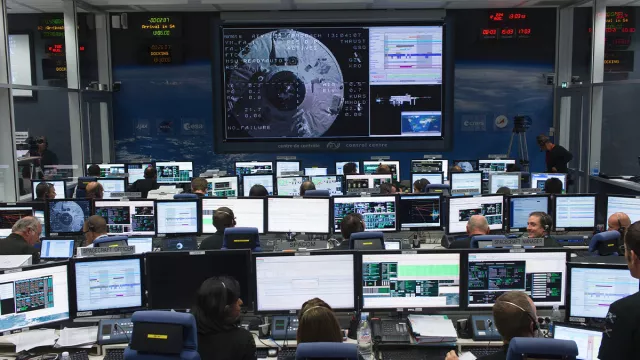Europe’s Automated Transfer Vehicle (ATV) was a spacecraft developed by the European Space Agency (ESA) to resupply the International Space Station (ISS). It had enough capacity for up to 8 tonnes of equipment and was capable of docking automatically with the station under the watchful eye of the ATV-CC.
Key information
| Mission | Supply and operate a semi-automated cargo spacecraft designed to resupply the International Space Station |
|---|---|
| Domain | Cross-cutting |
| First flight | 9 March 2008 |
| Partners | ESA |
| Where | Toulouse, International Space Station |
| Lifetime | 5 flights between 2008 and 2015 |
| Status | Completed |
ATV key figures
- 5 ATVs
- 35 tonnes of equipment ferried to ISS
- 10.47 tonnes empty mass
- 42 m3 pressurized volume
Control Centre (ATV-CC) key figures
- 500 people working on each mission
- 50 people on duty roster for each mission to provide round-the-clock monitoring
- 375 gigabytes of raw telemetry received
- 700 computers used for each mission
Key milestones
- 29 July 2014: Launch of ATV Georges Lemaître
- 5 June 2013: Launch of ATV Albert Einstein
- 23 March 2012: Launch of ATV Edoardo Amaldi
- 16 February 2011: Launch of ATV Johannes Kepler
- 9 March 2008: Launch of ATV Jules Verne
- Mid-2005: Start of testing on ATV Jules Verne
- 2003: ATV specifications set
- 2000: Phase B of ATV project
- End 1998: Decision to locate ATV-CC at CNES in Toulouse
Project in brief
On 16 December 1998, the European Space Agency (ESA) Council selected CNES, for its expertise in human spaceflight and satellite operations, to develop and operate the ATV Control Centre (ATV-CC) at the agency’s Toulouse Space Centre. This centre, interfacing with the control centres in Moscow (operating the Russian service module to which the ATV docked) and Houston (as supreme ISS authority operating the U.S. side of the ISS), was tasked with controlling operations and coordinating all ground support facilities required for ATV operations.
The ATV was a semi-automated spacecraft designed to resupply the International Space Station (ISS). It was a cylinder 10 metres long and 4.5 metres across with a cargo capacity of up to 8 tonnes, carrying equipment, oxygen, fuel, drinking water, food and scientific gear. Lofted into orbit by a dedicated variant of the Ariane 5 launcher and after several days in orbit controlled from the ATV-CC, the ATV would then dock autonomously with the ISS under the supervision of the ATV-CC and the centres in Houston and Korolev (Russia). Once docked, the carrier’s cargo was transferred to the station, after which it was filled with waste for the return trip. The ATV could stay berthed to the ISS for up to six months, using its thrusters when necessary to boost the station’s orbit, which decays over time as a result of atmospheric drag. Its thrusters also served to manoeuvre the ISS out of the way of space debris or to facilitate docking of other visiting spacecraft. After its stay in orbit, the ATV would undock from the station and then perform a series of de-orbiting manoeuvres—controlled remotely from the ATV-CC—before being burned up on re-entering Earth’s atmosphere.
Aboard the ISS, the crew prepared the station to accommodate the ATV, monitored rendezvous and docking operations (interrupting or scrubbing approaches if necessary), stored its cargo inside the station and then filled the ATV with waste for the return.
Developed by ESA, the ATV was designed to take over the ISS resupply role of the U.S. space shuttle retired from service in 2011. The first ATV, Jules Verne, was launched on 9 March 2008. This first mission also served to show the station’s international partners that the ATV system—spacecraft and ground segment—was capable of meeting its rendezvousing constraints. It took nearly one month to finalize this phase of the mission after numerous intermediate phases, including a test pass in survival mode. The ATV-CC’s Flight Dynamics Subsystem (FDS) teams thus planned and uplinked some 60 manoeuvres, an average of two a day.
ATV-2, Johannes Kepler, was launched in 2011, followed by ATV-3, Edoardo Amaldi, in 2012, ATV-4, Albert Einstein, in 2013 and ATV-5, Georges Lemaître, in 2014.
CNES’s role
While the ATV was developed by ESA, its control centre was developed and then operated by teams at CNES’s Toulouse Space Centre from launch through to the vehicle’s return to Earth, including the docked phase during which it became a fully-fledged module of the ISS.
In particular, CNES was tasked with analysing and optimizing ATV missions:
- Heeding the many constraints imposed by the vehicle’s designer and ISS partners (safety, manoeuvres, sensor glare, etc.).
- And keeping fuel burn and duration of operations to a minimum.
During ATV operations, the ATV-CC coordinated interfaces—ground systems and operations sequence—with our international partners and controlled the vehicle.
The international ground segment involved numerous partners:
- NASA through its control centre in Houston, operating tracking and data relay satellite (TDRS) ground facilities.
- The Russian federal space agency through its TsUP flight control centre in Korolev, outside Moscow.
- ESA through the European network control centre at DLR in Germany and the Artemis satellite controlled from Redu, Belgium.
- The Guiana Space Centre in Kourou, the Ariane 5 launch base.
For any questions, please use the website’s contact form.


